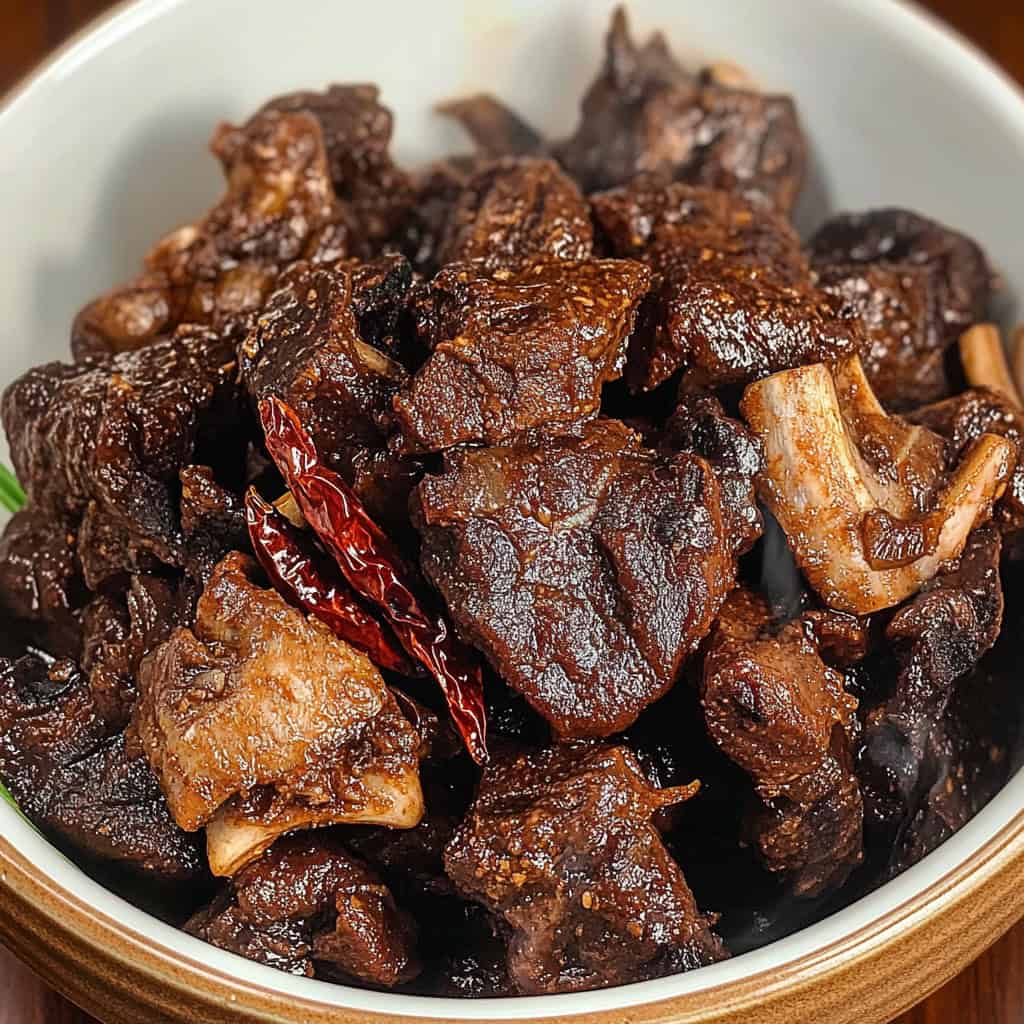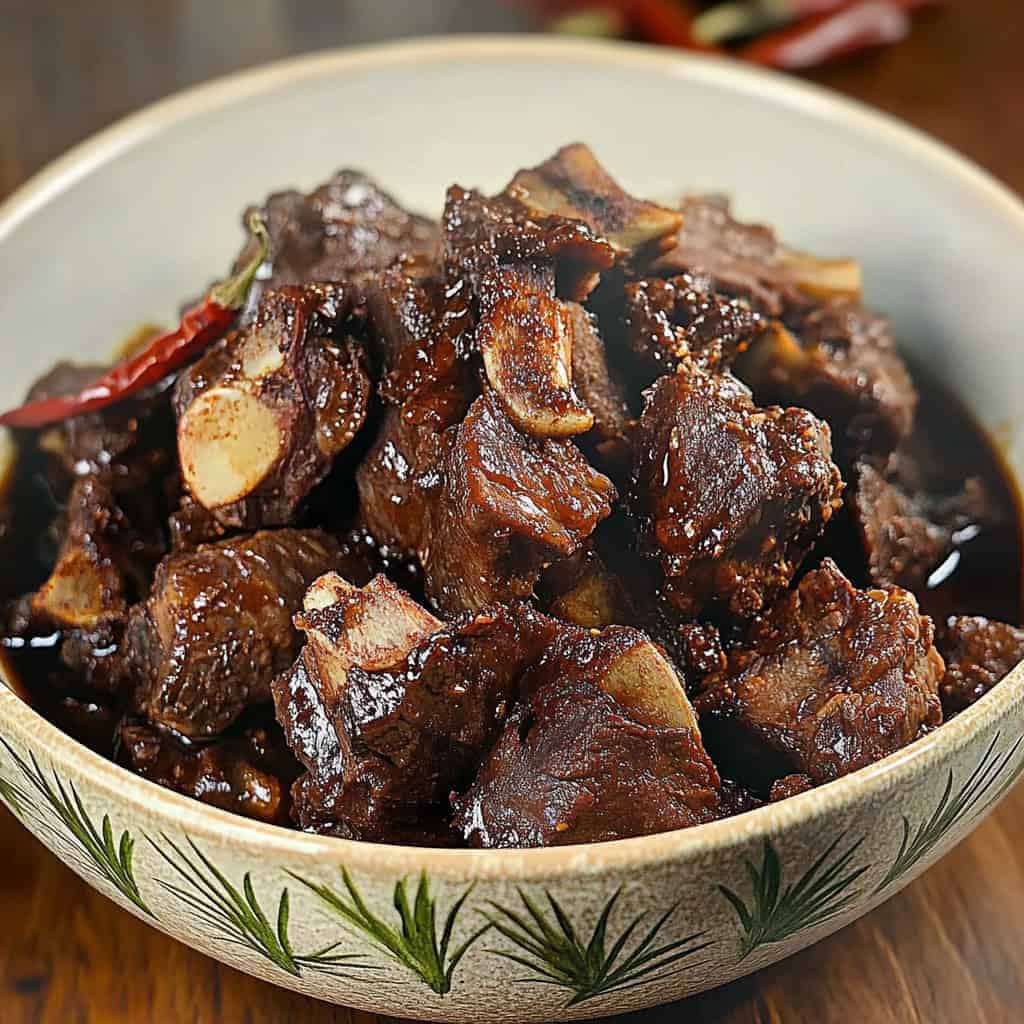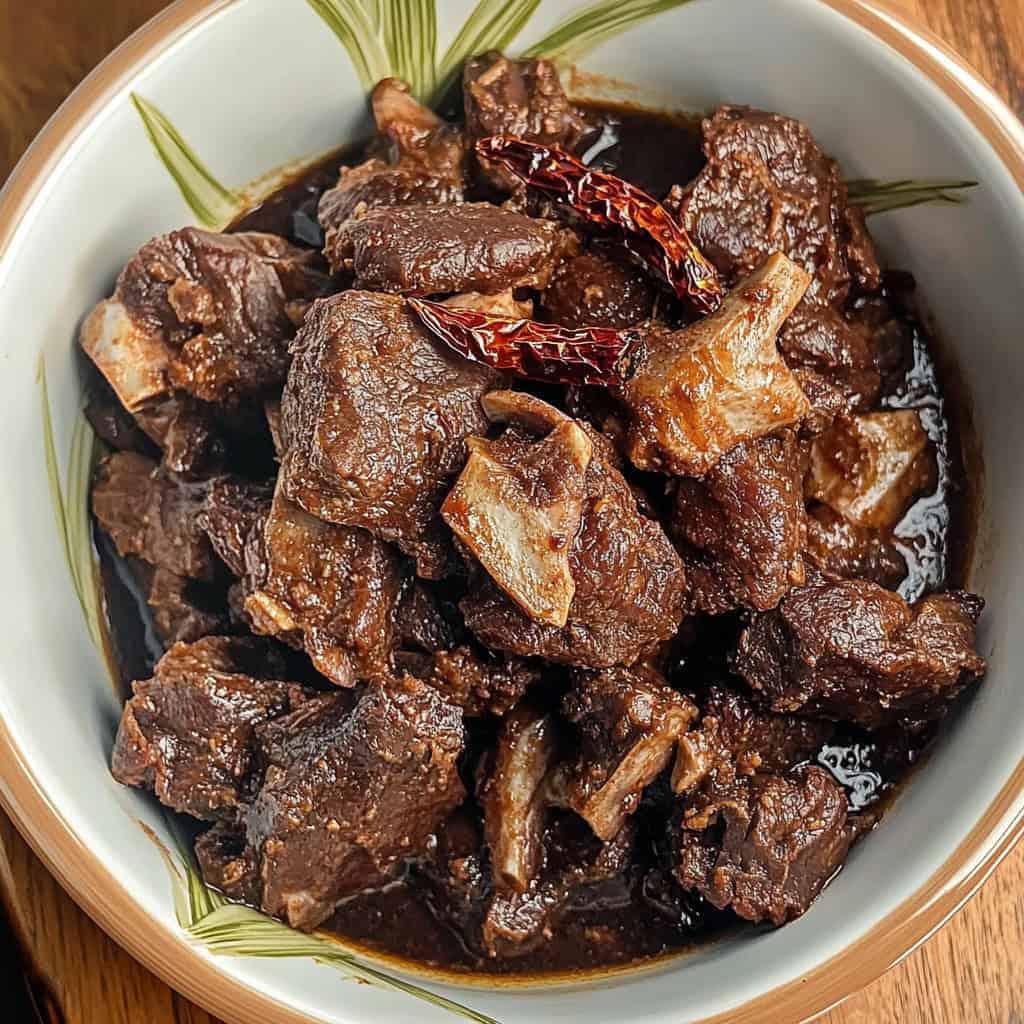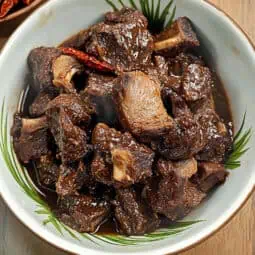Can we talk about how amazing Adobong Kambing is? I'll be honest, I was always a bit iffy about goat meat until I tried it adobo-style. The vinegar and soy sauce work their magic, transforming what could be tough, gamey meat into these tender, flavorful bites that practically melt in your mouth. And the best part? The sauce! You'll want extra rice to soak up every last drop.
If you've been hesitant about trying goat meat, this recipe is your perfect gateway dish. The familiar Filipino adobo flavors make it super approachable, and our special pre-cooking technique with ginger takes care of that strong goat smell that puts some people off. It's become my go-to order at kambingan restaurants, and now I'm excited to share how you can nail this dish at home.
Cultural Notes
Adobong Kambing represents the Filipino ingenuity in transforming strong-flavored meats into delectable dishes. Traditionally served during special occasions and gatherings, it showcases the Philippine adobo cooking technique while incorporating local ingredients and flavors.
Jump to:

Why You'll Love This Recipe
- Authentic Filipino flavors passed down through generations
- Tender, flavorful meat without any gamey taste
- Perfect balance of savory, tangy, and garlicky notes
- Versatile dish that works as both main course and pulutan
- Step-by-step instructions to ensure success
- Time-tested techniques for removing goat's strong odor
Ingredients
Each ingredient in this recipe plays a crucial role in creating the perfect Adobong Kambing. The ginger and onions in the pre-cooking stage neutralize the strong goat aroma, while vinegar and soy sauce form the essential tangy-savory base of Filipino adobo.
Garlic adds depth, peppercorns provide subtle heat, and bay leaves contribute an earthy aroma. The optional dried chilies offer customizable spiciness.
Together, these ingredients transform potentially tough goat meat into a tender, flavorful dish with perfect balance.

For Pre-cooking (Tenderizing Process):
- 1 kg goat meat, cut into 2-inch cubes
- 2 thumb-sized ginger, crushed
- 2 medium onions, quartered
- 4 cups water
- 1 tablespoon salt
For Adobo Sauce:
- ¼ cup soy sauce
- ¼ cup vinegar
- 8 cloves garlic, crushed
- 1 tablespoon whole peppercorns
- 4 dried bay leaves
- 5 dried chilies (optional)
- 3 tablespoons cooking oil
- 1 cup water
Equipment
- Large Heavy-Bottom Pot: For the initial boiling and tenderizing process. A thick-bottomed pot helps distribute heat evenly and prevents the meat from burning during the long pre-cooking stage.
- Deep Skillet or Kawali: For the final adobo cooking process. The wide surface area allows for better evaporation and sauce reduction.
- Sharp Knife: For trimming meat and chopping ingredients. A good sharp knife makes cutting through goat meat much easier.
- Strainer: For draining the pre-cooked meat efficiently without losing any pieces.
- Mortar and Pestle: For crushing peppercorns and garlic. This traditional tool helps release the aromatic oils better than a processor.
- Measuring Cups and Spoons: For precise ingredient portions to achieve the perfect balance of flavors.
- Wooden Spoon: For gentle stirring without scratching your cookware, especially important when working with acidic ingredients like vinegar.

How To Make
- Prep Work: Start by gathering all your ingredients. Cut 1 kg goat meat into 2-inch cubes, crush 2 thumbs of ginger and 8 cloves of garlic, and quarter 2 medium onions.
- Initial Boil: Fill a large pot with 4 cups of water. Add your crushed ginger, quartered onions, and 1 tablespoon of salt. Turn heat to medium-high (180°C/350°F) and bring to a boil.
- Pre-cook the Meat: Once boiling, add your goat meat to the pot. Lower the heat to a gentle simmer (140°C/285°F). Cover and cook for about 45-60 minutes, occasionally skimming off any scum that rises to the top. The meat should be tender enough that a fork easily goes through it.
- Drain and Set Aside: When the meat is tender, drain it in a strainer and set aside. You can discard the cooking liquid and aromatics.
- Start the Adobo Process: Get a deep pan and heat 3 tablespoons of cooking oil over medium heat (160°C/320°F). Add your crushed garlic and cook until it turns light golden brown.
- Brown the Meat: Add your pre-cooked goat meat to the pan. Stir and cook until the pieces are lightly browned on all sides.
- Add Basic Adobo Ingredients: Pour in ¼ cup soy sauce and 1 cup water. Add 1 tablespoon whole peppercorns and 4 dried bay leaves. Let this simmer for 10 minutes.
- Add Vinegar: Pour in ¼ cup vinegar. Important: do not stir right away. Let it boil for 2 minutes untouched. This technique helps preserve the vinegar's acidity and creates a more complex flavor.
- Reduce the Sauce: Lower the heat and simmer for 15-20 minutes until the sauce thickens to your liking. If you want it spicy, add 5 dried chilies in the last 5 minutes.
- Finish the Dish: Your Adobong Kambing is ready when the sauce has reduced and coats the meat nicely. Serve hot with steamed rice.

Tips from Lola's Kitchen
- Choose Young Meat: Select young goat meat (cabrito/kid goat) for more tender results. The meat should have a pinkish-red color and firm texture.
- Ginger is Key: Never skip the pre-cooking step with ginger - it's crucial for removing the gamey smell. For extremely strong-smelling meat, double the ginger amount.
- Pineapple Tenderizer: For extra tender meat, marinate in pineapple juice for 30 minutes before cooking. The natural enzymes help break down tough fibers.
- Respect the Vinegar: Don't stir immediately after adding vinegar. This cooking technique allows the vinegar to maintain its acidity while mellowing its harshness.
- Whole Spices Matter: Use whole black peppercorns instead of ground for better flavor development during the long cooking process.
- Low and Slow: Patience is key with goat meat. Maintain a gentle simmer throughout the cooking process for the most tender results.
- Rest Before Serving: Let the dish rest for 10-15 minutes after cooking. This allows the flavors to settle and the meat to absorb more sauce.
Substitutions
- Vinegar Alternatives: White vinegar can be replaced with apple cider vinegar for a milder tang or sugar cane vinegar (sukang Iloko) for a more complex flavor.
- Soy Sauce Options: Traditional soy sauce can be substituted with liquid aminos or coconut aminos for a gluten-free version with slightly different flavor profiles.
- Herb Swaps: If you can't find dried bay leaves, fresh curry leaves can work as an alternative, though you'll need to double the amount.
- Chili Options: Dried chilies can be replaced with fresh bird's eye chilies (siling labuyo) or any hot pepper of your choice, adjusting quantity to your heat preference.
- Meat Alternatives: While authentic Adobong Kambing uses goat meat, this recipe works well with beef chuck, pork shoulder, or even chicken thighs with adjusted cooking times.
Troubleshooting
- Meat Too Tough: If your meat is still tough after pre-cooking, extend the simmering time by 15-30 minutes. Make sure you're using gentle heat - boiling too vigorously can toughen the meat.
- Too Salty: Add a quartered potato to the dish and simmer for 10 minutes - the potato will absorb excess salt. Remove the potato before serving.
- Sauce Too Thin: Continue simmering uncovered until the sauce reduces to your desired consistency. If you're in a hurry, you can make a slurry with 1 teaspoon cornstarch and 2 tablespoons water.
- Strong Smell Persists: Double the ginger in the pre-cooking stage and add a splash of calamansi or lemon juice to the final dish to help neutralize any remaining gamey notes.
- Overly Acidic: If the vinegar taste is too strong, add ½ teaspoon of brown sugar to balance the acidity without making the dish sweet.
Storage & Reheating
- Refrigeration: Store in an airtight container for up to 3 days. The flavors actually improve overnight as the meat continues to absorb the sauce.
- Freezing: Freeze for up to 2 months in portion-sized containers. Thaw completely in the refrigerator before reheating.
- Reheating Method: Reheat gently on the stovetop over medium-low heat with a splash of water to prevent the sauce from becoming too thick. Stir occasionally until heated through.
- Serving After Storage: The dish is best consumed within 24 hours for optimal flavor, but remains delicious for several days when properly stored.
- Oil Separation: If you notice oil separation after refrigeration, simply stir the dish while reheating to reincorporate all the flavors.

FAQ
Why is my goat meat tough even after following the recipe?
Goat meat can vary in tenderness based on the animal's age. For consistently tender results, look specifically for young goat meat (kid or cabrito) and ensure you're using the gentle simmering technique. Never rush the pre-cooking stage.
Can I make this dish in advance for a party?
Absolutely! Adobong Kambing actually improves in flavor when made a day ahead. Store it in the refrigerator and gently reheat before serving, adding a bit of water if needed to maintain the sauce consistency.
How do I know if goat meat is fresh when shopping?
Fresh goat meat should have a pinkish-red color (never dark red or brown), firm texture when pressed, and only a mild smell. If possible, purchase from a reputable butcher who specializes in goat meat.
Can I use this recipe for other meats?
Yes, this recipe works wonderfully with beef chuck, pork shoulder, or chicken thighs. Adjust cooking times accordingly: beef will need similar timing, pork slightly less, and chicken significantly less pre-cooking time.
Is there a way to make this dish less fatty?
Yes, after the pre-cooking stage, refrigerate the meat for a few hours or overnight. This allows the fat to rise and solidify on top, which you can then easily remove before proceeding with the recipe.
Can I make this in a slow cooker or pressure cooker?
Absolutely. For slow cookers, complete the pre-cooking stage first, then transfer to a slow cooker with the adobo ingredients for 4-6 hours on low. For pressure cookers, pre-cook under pressure for 20 minutes, then continue with the adobo stage in sauté mode.
How spicy is this dish traditionally?
The traditional version is moderately spicy from the peppercorns, but not overwhelmingly hot. The dried chilies are optional and can be adjusted based on your heat preference.
Related
Looking for other recipes like this? Try these:

Adobong Kambing (Filipino Goat Adobo)
Equipment
- Large Heavy-Bottom Pot (Kaldero) For initial boiling and tenderizing
- Deep skillet or kawali For the final adobo cooking process
- Sharp knife (kutsilyo) For trimming meat and chopping ingredients
- Strainer [Salaan] For draining the pre-cooked meat
- Mortar and pestle (dikdikan) For crushing peppercorns and garlic
- Measuring cups and spoons (Panukat) For precise ingredient portions
- Wooden spoon (sandok na kahoy) For gentle stirring without scratching
Ingredients
For Pre-cooking (Pagpapalambot)
- 1 kg goat meat karne ng kambing, cut into 2-inch cubes
- 2 thumb-sized ginger luya, crushed
- 2 medium onions sibuyas, quartered
- 4 cups water tubig
- 1 tablespoon salt asin
For Adobo Sauce
- ¼ cup soy sauce toyo
- ¼ cup vinegar suka
- 8 cloves garlic bawang, crushed
- 1 tablespoon whole peppercorns paminta
- 4 dried bay leaves dahon ng laurel
- 5 dried chilies siling pangsigang - optional
- 3 tablespoons cooking oil mantika
- 1 cup water tubig
Instructions
- Start by gathering all your ingredients. Cut 1 kg goat meat into 2-inch cubes, crush 2 thumbs of ginger and 8 cloves of garlic, and quarter 2 medium onions.
- Fill a large pot with 4 cups of water. Add your crushed ginger, quartered onions, and 1 tablespoon of salt. Turn heat to medium-high (180°C/350°F) and bring to a boil.
- Once boiling, add your goat meat to the pot. Lower the heat to a gentle simmer (140°C/285°F). Cover and cook for about 45-60 minutes, occasionally skimming off any scum that rises to the top. The meat should be tender enough that a fork easily goes through it.
- When the meat is tender, drain it in a strainer and set aside. You can discard the cooking liquid and aromatics.
- Get a deep pan and heat 3 tablespoons of cooking oil over medium heat (160°C/320°F). Add your crushed garlic and cook until it turns light golden brown.
- Add your pre-cooked goat meat to the pan. Stir and cook until the pieces are lightly browned on all sides.
- Pour in ¼ cup soy sauce and 1 cup water. Add 1 tablespoon whole peppercorns and 4 dried bay leaves. Let this simmer for 10 minutes.
- Add ¼ cup vinegar. Important: do not stir right away. Let it boil for 2 minutes untouched.
- Lower the heat and simmer for 15-20 minutes until the sauce thickens to your liking. If you want it spicy, add 5 dried chilies in the last 5 minutes.
- Your Adobong Kambing is ready when the sauce has reduced and coats the meat nicely. Serve hot with steamed rice.
- Remember: You can always adjust the seasoning to taste before serving. If the sauce is too thin, simply simmer longer. If it's too thick, add a splash of water.
Tips from Lola's Kitchen
- Choose young goat meat (cabrito/kissing) for more tender results
- Never skip the pre-cooking step with ginger - it's crucial for removing the gamey smell
- For extra tender meat, marinate in pineapple juice for 30 minutes before cooking
- Don't stir immediately after adding vinegar to achieve the best flavor
- Add whole black peppercorns instead of ground for better flavor development
Nutrition
The Story Behind Adobong Kambing
In the sun-drenched provinces of the Philippines, where fresh ingredients and time-honored cooking methods merge, Adobong Kambing stands as a testament to Filipino culinary ingenuity. This dish emerged from the practical need to preserve meat in the tropical climate, combining the Spanish influence of vinegar-based preservation with indigenous cooking methods and Chinese-inspired use of soy sauce.
Goat meat, locally known as 'karne ng kambing,' has been a staple in Filipino cuisine long before the Spanish colonial period. Rural communities, particularly in regions like Pampanga, Nueva Ecija, and Batangas, developed various ways to prepare goat meat, from the spicy Kaldereta to the soupy Sinampalukang Kambing. However, it was the adoption of the adobo cooking technique that truly transformed how Filipinos enjoyed goat meat.
The genius of Adobong Kambing lies in its two-step cooking process, a method perfected by generations of Filipino home cooks. The initial boiling with ginger and aromatics, known locally as 'pagpapalambot,' was developed specifically to address the strong gamey flavor that often deterred people from enjoying goat meat. This technique, paired with the traditional adobo method of cooking in vinegar and soy sauce, created a dish that even those skeptical of goat meat came to love.
Today, Adobong Kambing has evolved from being just a preservation method to becoming a celebrated dish in Filipino cuisine. You'll find it being served in humble carinderias (local eateries), specialized kambingan (goat restaurants), and even upscale Filipino restaurants. It's particularly popular as pulutan – a dish served with alcoholic beverages – where its rich, bold flavors perfectly complement ice-cold beer during social gatherings.
The dish has gained such popularity that many regions now have their own variations. Some versions in Mindanao incorporate coconut milk for added richness, while others in the Ilocos region use the more potent sukang Iloko (sugarcane vinegar) for a distinct tang. In Metro Manila, modern interpretations might include additional herbs or a touch of citrus, though the core cooking technique remains unchanged.
What makes Adobong Kambing truly special is how it embodies the Filipino spirit of making something extraordinary from humble ingredients. Through careful preparation and cooking, what might be considered a challenging meat to work with is transformed into a dish that's not just edible, but crave-worthy. It's a perfect example of how Filipino cuisine turns limitations into opportunities, creating flavors that continue to captivate both locals and international food enthusiasts alike.










Comments
No Comments